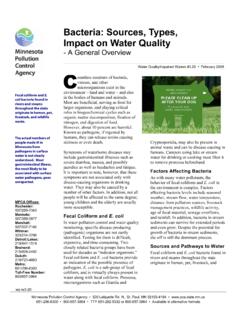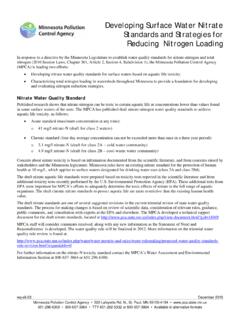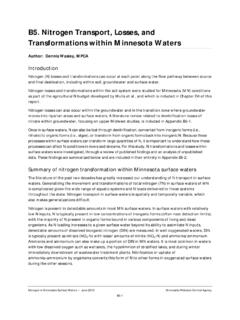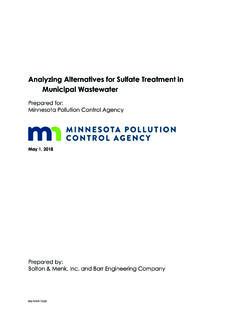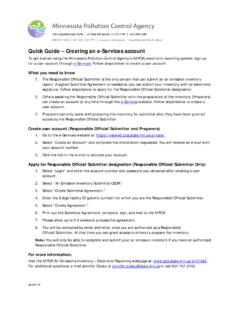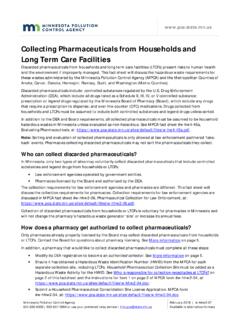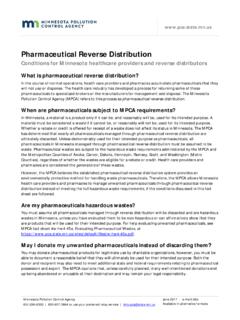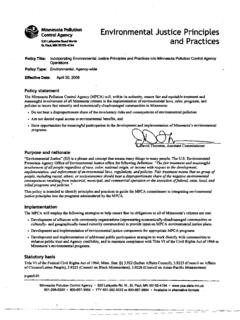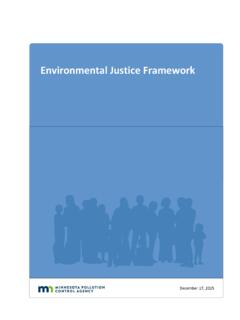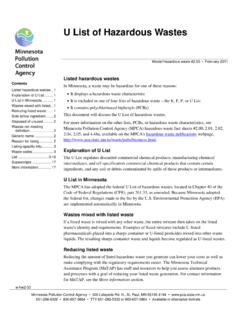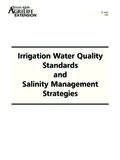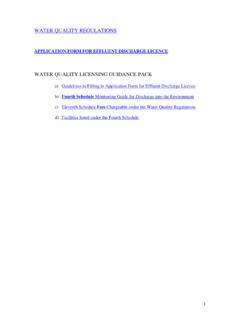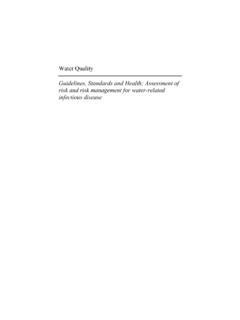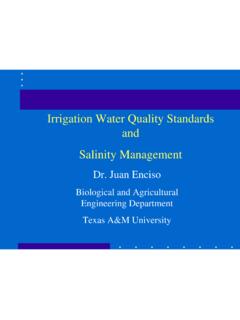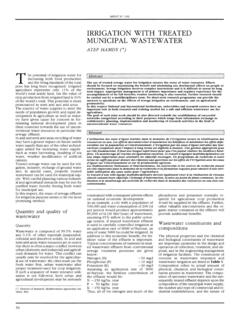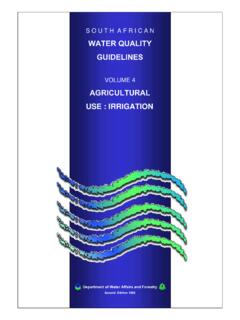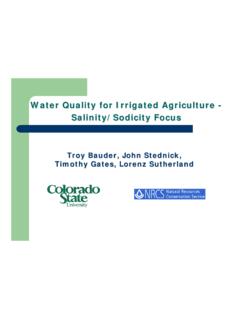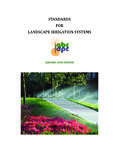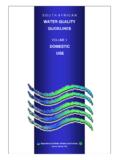Transcription of Class 3 and 4 Water Quality Standards Revisions
1 Version Date: November 18, 2010 Technical Support Document Summary: University of Minnesota Class 3 and Class 4 water quality standards Review Minnesota Surface Water Quality Investigation Industrial Supply, irrigation and Livestock Uses June 29, 2010 Introduction: The following summary provides a brief overview regarding possible changes to the State s Class 3 (Industrial Consumption) and Class 4 (Agriculture and Wildlife) Water Quality Standards found in Minn. R. and Minn. R. , respectively. This summary was completed by MPCA staff based on their review of the University of Minnesota (U of M) Class 3 and Class 4 water quality standards Review report and correspondence with the U of M authors. Background Information: The Class 3 and the Class 4 Standards were first adopted into rule on a state-wide basis in the late 1960s and have remained largely unchanged since that time.
2 Over the last eight-to-ten years, certain industrial sector dischargers have been assigned stringent "salt-related" effluent limits. This is especially true for food processing industries and ethanol production facilities that employ Water conservation techniques or process their incoming Water using reverse osmosis technologies and that discharge their treated wastewaters to low flow receiving waters. In many of these instances, the Class 3 and Class 4 water quality standards translate into "end of pipe" limitations; often times protecting a resource that, due to its low flow characteristics, does not provide sustainable Water for either industrial or irrigation purposes. This situation is not restricted to industrial dischargers.
3 Effluents of similar Quality can also be found in municipal wastewater treatment facility discharges, particularly those in hard Water areas of the state where Water softening is done on an individual basis. While a re-examination of the Class 3 and Class 4 Standards has been proposed several times in the past, other priority rule related issues have taken precedence ahead of the re-evaluation of these Standards . As part of the 2008-2012 triennial rulemaking review, the Minnesota Pollution Control Agency (MPCA) contracted with the Department of Bioproducts and Biosystems Engineering at the U of M to conduct this re-examination. University faculty and staff with expertise in the area of industrial Water use requirements and Quality control, crop production, irrigation , and livestock and wildlife physiology participated in this review.
4 The work product of this re-examination is the appended technical report titled Minnesota Surface Water Quality Investigation Industrial Supply, irrigation and Livestock Uses. This technical report is intended to serve as a key resource document providing information in support of potential rule amendments to the Standards associated with the Class 3 and Class 4 use classifications. Recommended and Proposed Class 3 and Class 4 Rule Changes: The tables below show a comparison of existing Class 3 and Class 4 water quality standards and the recommended changes and additions contained in the U of M report and/or those that are wq-s6-172 being proposed by MPCA staff. As with other documents and comments provided to the MPCA on the re-examination of the Class 3 and Class 4 water quality standards , the U of M recommendations will be considered by MPCA staff in the development of the Statement of Need and Reasonableness (SONAR).
5 The rulemaking SONAR, which is the State s affirmative presentation of information supporting proposed rule amendments, is scheduled for completion in late summer, 2011. Additional literature reviews and searches are being conducted in order to evaluate these recommendations with an eye towards conditions and applications specific to Minnesota. As such, the values listed in the tables below, or the range of values listed below, are considered to be draft listings which may change as MPCA staff move further along the rulemaking review process. Class 3 Industrial Consumption Use Class 3 Industrial Consumption Use Existing Standards Class Chlorides mg/L Total Hardness (Ca + Mg as CaCO3) mg/L pH minimum pH maximum 3A 50 50 3B 100 250 3C 250 500 3D Maintain Background Maintain Background Maintain Background Maintain Background For the Class 3D use classification, maintain background means the concentration of the Water Quality substance, characteristic.
6 Or pollutant shall not deviate from the range of natural background concentrations or conditions such that there is a potential significant adverse impact to the designated uses. A general conclusion offered in the U of M report indicates that industrial Water appropriators are concerned about consistency and availability (quantity) of intake Water and that they are willing to treat the incoming Water to meet their specific process needs. MPCA staff is considering two possible approaches that would result in changes the Class 3 Water use Standards . The first option would maintain the concept of presumptive applicability whereby most waters of the state would remain classified for Class 3 industrial consumption uses. However, instead of the numeric Standards specified above for the various Class 3 subclasses ( Class 3A, 3B, 3C, or 3D), narrative Standards for a single Class 3 use category would be developed.
7 Based on the current multi-use classification system the state employs, for most waters, the industrial Quality criteria would then be governed by the applicable Class 2 numeric and narrative Standards assigned to the given Water body. Simply stated, if the surface Water is of adequate Quality to support aquatic life and recreational uses ( Class 2) it would be judged to be of an acceptable Quality for industrial withdrawal and subsequent treatment by the Water appropriator for industrial use. Under this approach, Class 7 limited resource value waters would not be classified for Class 3 3 uses given the fact most Class 7 waters are low flow watercourses that do not have adequate year-round volumes of Water for industrial withdrawal purposes.
8 The second option being considered would move away from the concept of presumptive applicability as it pertains to assigning Class 3 use classifications. Under this approach, the MPCA would retain the Class 3 sub-classifications and their accompanying Standards but be more selective and assign the Class 3 use Class to larger river systems and lakes throughout the state. Defining which waters of the state would receive the Class 3 use classification would be accomplished by reviewing the stream flow characteristics for waters that serve as industrial source waters in existing Minnesota Department of Natural Resources Water appropriation permits. As the U of M report points out, on a volume basis, approximately 98% of surface Water withdrawals are associated with industrial uses; with power generation being the dominant use category.
9 Either of the two options noted above would provide a more practical approach to classifying waters of the state for industrial uses. Class 4A Agriculture ( irrigation ) Use Class 4A Standards are intended to permit Water irrigation uses without significant damage or adverse effects upon any crops or vegetation usually grown in the waters or area, including truck garden crops. The following table presents the existing Class 4A Water Quality Standards (Minn. R. , subp. 2) and the concentrations, or ranges of concentrations, being considered for potential amendment. Class 4A Agricultural Use and irrigation - Existing Standards and Draft Proposed Surface Water irrigation Standards Existing Standards Draft Proposed Standards Bicarbonates (HCO3) 5 milliequivalents per liter 5 milliequivalents per liter Boron (B) mg/L Range of values being considered: 2 mg/L pH, minimum value pH, maximum value Specific conductance 1,000 micromhos per centimeter at 25 C Range of values being considered.
10 1,200 1,700 micromhos per centimeter at 25 C Total dissolved salts 1 700 mg/L Remove Sodium (Na) 60% of total cations as milliequivalents per liter 60% of total cations as milliequivalents per liter Sulfates (SO4) 2 [See footnote number 2 below] 10 mg/L, applicable to Water used for production of wild rice during periods when the rice may be No numeric change proposed at this time pending additional studies; (See footnote 2). 4 susceptible to damage by high sulfate levels. Radioactive materials Not to exceed the lowest concentrations permitted to be discharged to an uncontrolled environment as prescribed by the appropriate authority having control over their use. Not to exceed the lowest concentrations permitted to be discharged to an uncontrolled environment as prescribed by the appropriate authority having control over their use.
